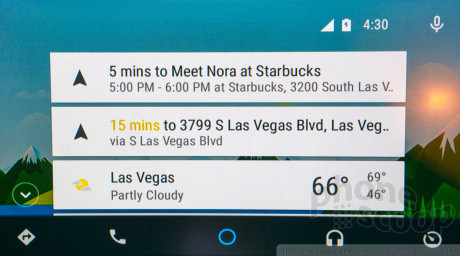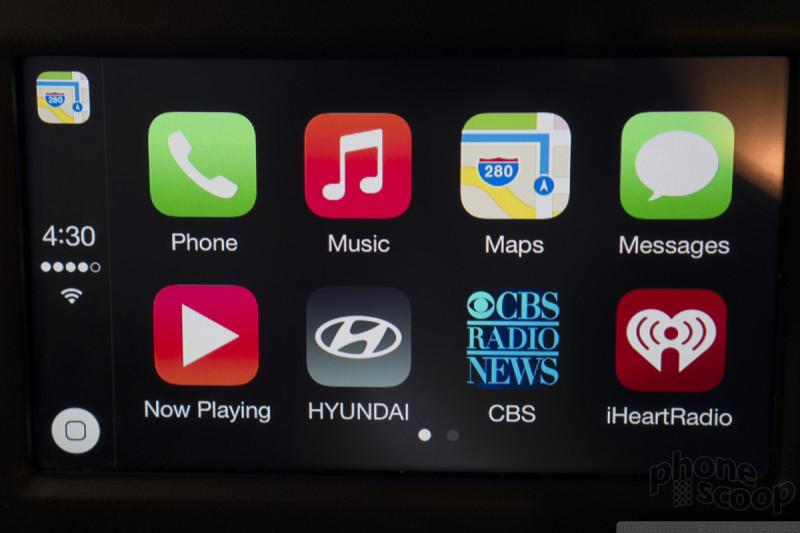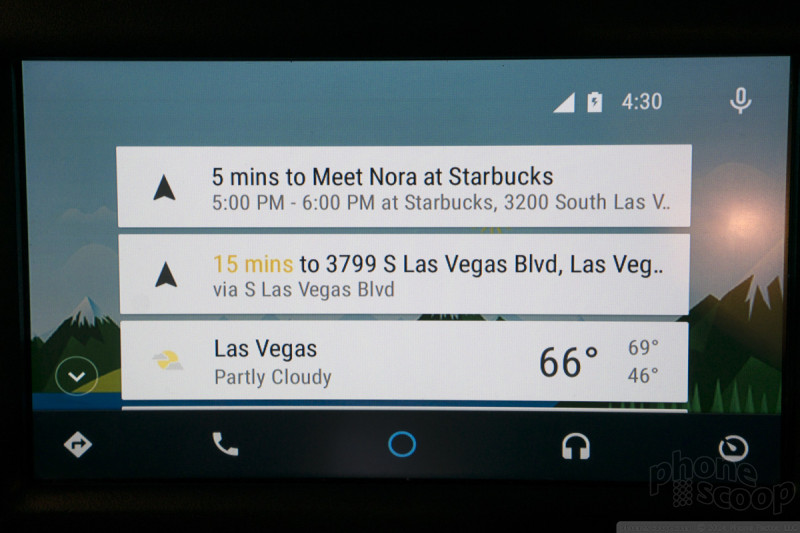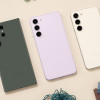CarPlay vs. Android Auto
Feb 20, 2015, 4:40 PM by Rich Brome @rbrome.bsky.social
updated Feb 23, 2015, 2:15 PM

By all accounts, both Apple and Google have bold ambitions in the automotive space. But an Apple or Google Car is many years away. What's available today are CarPlay and Android Auto, both of which take a major new step in integrating your phone with your car. They're remarkably similar, both extending your phone's interface to the touch screen in your dash, but relying mostly on voice interaction for safe use while driving. In the this in-depth hands-on, we take a look at how they work, their striking similarities, and how they differ.
Intro
When Apple announced CarPlay almost a year ago, it marked a bold change in direction for the relationship between phones and cars - and between the companies making those products. Google quickly followed with the very similar Android Auto.
Previously, car dashboard systems were the vehicle's nerve center, connecting to phones in limited ways, to pipe audio, import contacts, and - at the most sophisticated - integrate with streaming music apps. But cars have longer development cycles than phones, and longer lifespans, meaning your car dash system will almost always feel outdated, especially next to your phone.
CarPlay and Android Auto work the opposite way, putting your phone in charge of the touch screen in your dash. Although car makers are keen on their own dash systems, CarPlay and Android Auto are a great way to make consumers happy and keep a fresh touch interface on the car's dash, even as a car ages.
Some new cars hitting the market this year support CarPlay or Android Auto, and many will support both. Brands committed to both include Audi, Chevy, Chrysler, Dodge, Fiat, Ford, Honda, Hyundai, Jeep, Kia, Mazda, Nissan, Subaru, VW, and Volvo. At the luxury end, things are more divided. BMW, Mercedes, and Jaguar are in the CarPlay camp, while Acura has picked Android Auto. For older cars, aftermarket audio companies like Pioneer make dash units supporting both, which can be installed in many cars.
CarPlay and Android Auto are remarkably similar. While the interfaces look quite different, the features and concepts are almost exactly the same. Both have a strictly limited feature set and an emphasis on voice interaction. Both technically allow third-party apps, but currently only third-party audio services (such as Spotify and Pandora) are available.
Going down the checklist of features and attributes, it would be easy to believe that Google flat-out copied Apple's CarPlay when developing Android Auto. The features - and limitations - really are that similar.
Both Android Auto and CarPlay require that you connect your phone to the car via a USB cable. That's sensible, as most people like to charge their phone in their car, and things like voice control and navigation are notorious battery hogs. But if wireless charging ever takes off, it would make sense for CarPlay and Android Auto to support wireless connections as well. There are reports that Apple is already working on an update to iOS that supports CarPlay over Bluetooth.
There's a third alternative to CarPlay and Android Auto, called MirrorLink. It could work with any phone in theory, but as it's not supported by Apple, it's effectively limited to Android, where manufacturers like Samsung and HTC have added it to some of their phones. Pioneer also supports it in many of its aftermarket dash units.
MirrorLink is just different and open enough to potentially be really exciting. It had some industry support early on, but unfortunately, that has quickly been drowned out in the face of heavyweights CarPlay and Android Auto.
MirrorLink is much more open than the big two, providing only a very loose framework for apps, not a complete car solution. There is no standard MirrorLink Phone app, Maps app, or Music app, for example. MirrorLink does have safety standards to prevent apps that distract drivers too much, but otherwise it seems very open to creative types of apps. It supports a few really interesting features, such as connections over Wi-Fi instead of USB, and the ability for apps to pull in certain data from the car systems (although it's not clear any cars will support this feature in a meaningful way.)
I want to see MirrorLink succeed, but find it difficult to be optimistic about its chances.
CarPlay
CarPlay strives to make you feel at home with its familiar grid of app icons on its home screen. Everything is laid out differently and works differently than on your phone, yet it still manages to look and feel familiar. The changes are all designed to make it safer to use while driving. Apple has done a remarkable job of changing nearly everything while ensuring that everyone who owns an iPhone will know exactly how to use it from day one.
CarPlay's home screen only displays apps that are specifically designed to work with CarPlay. Most of the apps are built-in Apple apps. The first batch of third-party apps are streaming audio services like Spotify and CBS Radio News. Apple is tightly controlling who can develop apps for CarPlay, but has promised to open it up to more developers soon. Apple and Google have both put in place rules about what apps can't do, to keep you from getting too distracted while driving.
The way Apple has designed CarPlay, the door is left open for more creative apps beyond just streaming audio, such as apps that tell you what's ahead (traffic, road conditions, weather, food, gas, etc.) or something like a location-based audio trivia app. Perhaps the Automatic app could even show you nerdy details about what's going on under the hood, right on your dash. Apple doesn't seem to allow these types of apps quite yet, but they have promised to expand the APIs in the future, and it's obvious how that might work. That's a potential advantage over Android Auto, which has no app menu and offers no way for apps to take over the screen.
The core apps of CarPlay are Phone, Music, Maps, and Messages. Each of these rely heavily on Siri for interactive voice control, and you can also access Siri directly by holding the virtual home button on the screen, or the voice button on your steering wheel (if your car has one.) So launching an app like Phone or Messages from the on-screen icon will trigger Siri to ask you who you want to call or message. Or you can trigger Siri yourself and say something like "New message to Eric". Siri can of course also take you to an address, find the nearest coffee shop, or play a specific song.
The interface is intentionally very limited to keep you from being too distracted while driving. You can't summon a keyboard to type a message or enter an address. You can't even display a message to read on the screen. These functions - and anything else that would take your eyes off the road for more than a half-second - must be done by voice, for safety's sake.
The CarPlay interface has a typically classy Apple style to it, making it many times more attractive than the typical Windows-95-esque graphics most car makers seem to design. But while CarPlay's graphics look modern and dignified, they're also relatively generic and boring. On the plus side, the graphics are very easy to read at a glance, again, for safety's sake. They have a timeless quality that blends in with any dash design. But it's also the least sexy interface Apple has put out in a decade, so it's hard not to feel a little let down. And it doesn't compare favorably against Android Auto's sexy Material Design interface.
Android Auto
The features of Android Auto are nearly identical to CarPlay. The main controls are simply a set of buttons across the bottom of the screen for Maps, Phone, and Music.
There is no proper app menu; at first glance, third-party app support is limited to a list of audio services within Google's own Music app.
Android apps can also surface notifications of new messages through Android Auto. Users can have the text of those messages read aloud, and take action by voice, including replies. At the moment, that message-and-reply function enables certain third-party app functionality that doesn't seem possible on Apple's CarPlay. But apps using the reply function don't get an icon, nor any way to invoke them proactively while driving. Want to send a WhatsApp message to a friend while driving? Tough luck, unless they happen to message you first, giving you the opportunity to reply.
Unfortunately, Android Auto's interface seems to preclude more interesting third-party apps; it's not clear where they would fit in without a complete redesign by Google. Third-party app support is extremely limited, and, based on the design, Google aims to keep it that way. That could become a major disadvantage of Android Auto.
Even with the currently-allowed apps, it's confusing to have a podcast app like Joyride available only from within the "Music" part of Android Auto. So the design, while pretty, is not only limiting, but confusing.
Where Android Auto differentiates itself is the home screen, which is based on the excellent Google Now card interface. It's not as immediately intuitive as what Apple has done, as Google is in charge of what you see and when. (Looking for a Messages icon? Good luck.) But if you've used Google Now on an Android phone - or an Android Wear watch - you'll feel right at home. New notifications - such as text messages - appear and can be acted on from this card interface, and it works almost exactly like Android Wear. You'll also find little extra features like weather on the home screen. As with any other place you might interact with Google Now, it's a powerful interface once you master the short learning curve and begin to trust it.
We noticed some bugs in our demos. When composing a message, it would frequently ask for the recipient's name twice, even though it seemed to understand the name the first time. But since the software lives on the phone, new versions of the OS can easily fix these kinds of bugs (the same is true for CarPlay.)
Both CarPlay and Android Auto offer comprehensive map and navigation services, and both attempt a certain amount of intelligence to reduce the need to touch the screen. For example, if someone recently texted you an address, that will automatically be the top navigation suggestion.
It's remarkable how much Android Auto is like Android Wear, and how well that interface works for both scenarios. That's also an area where Google and Apple have diverged in strategy: Google has essentially one interface for any secondary window into your phone. Apple has come up with two radically different solutions for your car and your wrist.
Both Android Auto and CarPlay are currently designed for a traditional rectangular screen. But Sharp was at CES this year showing off its "FreeForm" displays that can be made in any shape, and are aimed squarely at the automobile market. As much as car makers love to differentiate on style, it's not hard to see this technology taking off. And if your next car has a round display in the dash, it's not hard to see how Google might adapt the Android Auto interface to fit it, much as it did with Android Wear for round watches. Unfortunately, it's difficult to see how Apple might adapt the CarPlay interface for different display shapes.
Ultimately, both CarPlay and Android Auto are solid first attempts at linking your car to your phone. They both succeed at bringing a first-rate navigation, communication, and music experience to your dash, with excellent interactive voice control. The experience with either system is leagues better than anything previously available in any car. That alone makes them compelling for any smartphone owner who spends a lot of time in their car. I simply wouldn't consider a new car without one or both.
Curiously, neither has a clear advantage over the other. In spite of small differences, these 1.0 versions perform most of the same functions, and do all of them fairly well. Neither is a compelling reason to choose one smartphone platform over the other; Apple and Google are just keeping pace here. That could change with later versions. It will be interesting to see where Google and Apple steer these platforms down the road.
Comments
Saw both demos at CES
How will it work without phone
WOW



































 iPhone 15 Series Goes All-In on USB-C and Dynamic Island
iPhone 15 Series Goes All-In on USB-C and Dynamic Island
 Samsung S24 Series Adds More AI, Updates the Hardware
Samsung S24 Series Adds More AI, Updates the Hardware
 iPhone 16 Brings More Features to All Price Points, Including New Camera Control
iPhone 16 Brings More Features to All Price Points, Including New Camera Control
 Google Adding AirDrop to Android
Google Adding AirDrop to Android
 Samsung Puts its Best Camera Yet in the Galaxy S23 Ultra
Samsung Puts its Best Camera Yet in the Galaxy S23 Ultra











